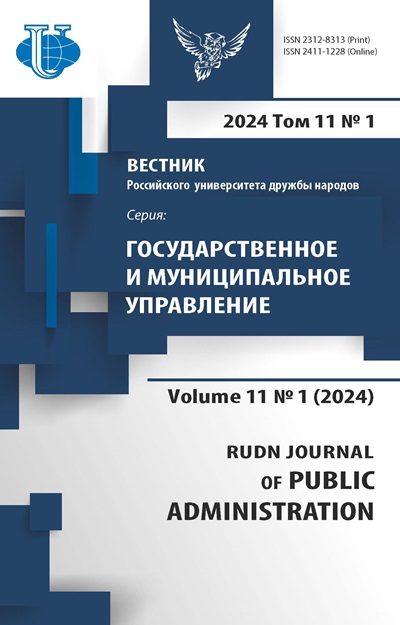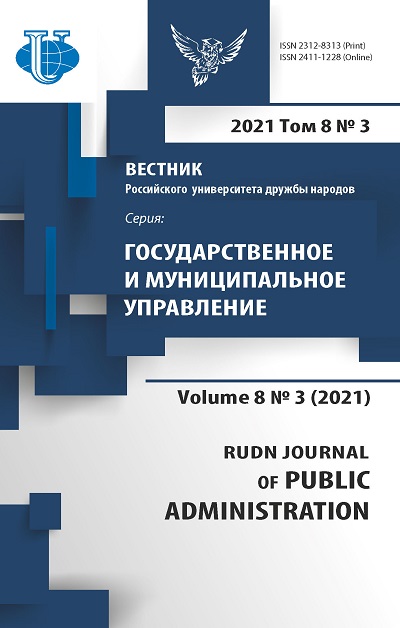Vol 8, No 3 (2021)
- Year: 2021
- Articles: 9
- URL: https://journals.rudn.ru/public-administration/issue/view/1460
- DOI: https://doi.org/10.22363/2312-8313-2021-8-3
Full Issue
Public administration: theory and practice
Unit Economics of Russian Political Parties: Political Consumerism and Ideological Factor
Abstract
The article uses the methods of unit economics to analyze inter-party competition in the Russian Federation on the example of the 2016 elections to the State Duma. The author concludes limited applicability of unit economics for the analysis of electoral strategies and prospects of both parliamentary and new parties. The current mechanism of state financing of political parties encourages them to drift in the direction of market or rental strategies.
 223-228
223-228


Management Techniques for Organizing Work in Government Institutions by the Proactive Approach and the Introduction of a “Turquoise” Model of Scientific Motivation of Employees
Abstract
The authors propose a scientific method of “proactive” motivation of staff, first applied in a public institution through the introduction of “turquoise” technologies of work organization. The purpose of the study was to prove the effectiveness of "turquoise" offices within the civil service. As a result of the experiment, the increased return from each employee is clearly shown, as well as an increase in the quality of work due to the increased diligence and responsibility of motivated employees. The authors prove that modern ways of organizing work with the help of “turquoise” technologies can raise the prestige of public service.
 229-238
229-238


State Management of National Resources at the Conceptual Level - Images and Meanings of State Symbols
Abstract
This article is a further continuation of the work on the review of the basics of state management of national resources (state and use), in relation to its system - forming function-state policy and political symbols (the conceptual level of management). From the system positions of the general theory of classification and systematization, the functions of state management of national resources are considered and the role and place of each of them in a single universal management circuit is determined. The role and place of political symbols (a sub-function of the conceptual-strategic level) are considered on the basis of the proposed invariant structure of the typical contour of state management of the state of national resources (operational-tactical level). From the modern state symbols of the Russian Federation, the iconic image “two - headed eagle” is selected and its prototypes and the origins of their origin, which are located in ancient times, are considered. To consider the evolution of the iconic images of state symbols of modern Russia, it is proposed to systematize and analyze them at different historical stages, to this end, systematize and analyze the following Old Testament images of power (state symbols) of various countries of the world: “non-predatory bird”, “bird of prey”, “griffin”, “two-headed eagle”, systematize and analyze the sacred images of power “double-headed eagle” and “griffin” in the symbolism of the countries of the world with the identification of their sacred meanings-binary (binary). Conclusions are drawn about the common origins of the origin and distribution of these Old Testament images of state symbols in the countries of the Indo-European community, the systematization and analysis of the Old Testament images of power (state symbols) of various countries of the world: “non-predatory bird”, “bird of prey”, “griffon”, “double - headed eagle” allows us to trace the evolution of the origin and formation of the main state symbol of Russia “double-headed eagle”, at the heart of the Old Testament images of power “griffin” and “double-headed eagle” in the symbolism of the countries of the world lie the sacred meanings of the universal and fundamental principle of reality (world, reality, being) - the duality (duality) of opposite, proportionate and balanced entities.
 239-255
239-255


Management Succession and Entrepreneurship Business Sustenance
Abstract
Succession planning has drawn substantial interest among researchers. Research reports designate deficiency of quality planning in the management of SMEs especially in developing countries like Nigeria and this constitutes a foremost limitation to the effective management of SMEs. Succession planning are fundamental to steady performance, sustainability and competitive advantage of SMEs. The objective of the study was to investigate the effects of HR planning/forecasting on family business continuity and also to examine the effect of worker’s education on survival of entrepreneur. 110 copies of questionnaire were administered to the employees in the five selected SMEs in Abeokuta Ogun state, Nigeria to get primary data that treated and tested appropriate research questions and hypotheses accordingly. Analysis of variance (ANOVA), correlation efficient and regression analysis was employed. The Yamane formula was used to determine the sample size. The test re-test reliability approach was adopted for the convenience of the researcher. Reliability was ensued by Cronbach’s Alpha of 0.932. The data was analyzed using manual and electronic based methods through the data preparation grid and statistical package for the social sciences, (SPSS). The study found out that HR succession planning significantly assists SMEs to increase business continuity and Workers education significantly assists SMEs to increase business survival. The study recommends that organizational succession planning should be at regular interval as this will enable workers to know its importance and also business successors should be appointed based on merit so that the right and experience successors can manage the business.
 256-276
256-276


Leadership and Effective Human Resource Management in Organization
Abstract
Outstanding leaders combine good strategic substance and effective interpersonal processes to formulate and implement strategies that produce results and sustainable competitive advantage. In today’s competitive business environment, the defining success factor is essentially leadership with the potential of transforming its employees into a willing and winning team with the appropriate synergy to actualize collectively determined corporate missions and aspirations. The contemporary dynamics in the operating environment of business calls for leadership orientations which recognize that employees have emotional dividends to satisfy at workplace and should, thus, be managed in such a way that they are always able and willing to achieve enhanced performances. It is against this backdrop that this paper underscores the indispensability of leadership in the dayto-day dynamics of the organization and suggests a ramifying range of leadership styles that potentially conduce to optimal human resources management and performance. This paper utilized the methods of qualitative and syntheses of scientific literature as it relies on secondary data collected from books and journal articles, and were content analyzed in relation to the scope of the paper. Finally, the paper concludes that leadership synergizes the human resource and ensures that they continuously create value for the various stakeholders in the organization.
 277-296
277-296


INTERNATIONAL EXPERIENCE OF PUBLIC ADMINISTRATION
Public Participation In Preventing Covid-19 Outbreaks In Lampung Province, Indonesia
Abstract
The Covid-19 epidemic is the center of worldwide attention today not only in Indonesia but also in all parts of the world’s continents. In Lampung Province prevention of the spread of Covid-19 continues to be done by involving the community to be able to participate and play an active or passive role. The purpose of this study is to find out how public participation in preventing Covid-19 outbreaks in Lampung Province. This research uses a qualitative research method with a qualitative descriptive approach in which the researcher wants to describe and express phenomena and facts that occur clearly. The results showed that public participation in the prevention of Covid-19 outbreaks in Lampung Province was considered quite high, it was judged by the active role of the people of Lampung Province in preventing Covid-19 by carrying out healthy lifestyles, complying with regulations and appeals from the central and regional governments, and the awareness of the public to conduct social distancing in accordance with regulations from the central and regional governments. Even though it is not yet fully in good value and there are still people who violate it by ignoring the government’s appeal but the majority of people in Lampung Province are aware of the dangers of Covid-19. The Lampung Provincial Government together with the community until now also continues to monitor and work together to prevent the spread of Covid-19 in Lampung Province.
 297-311
297-311


Protest in Russia 2017-2021: Technologies and Patterns
Abstract
The article analyzes the patterns and technologies of organizing political protest in Russia in the period 2017-2021. The author concludes that the start of the protests in March 2017 was aimed at influencing the presidential elections in March 2018, in addition, the “protests of schoolchildren” were to launch the pattern of “chain reaction” in rising of protest actions. The author states that in this new wave of protests, there is a change of “face of protest”: that is an attempt to remove one of the main problems of Russian political protest - a large number of opinion leaders, each of whom has an extremely low rating, and the absence of single ideological orientation of the protest. Protest organization technologies share patterns with the radical mass forms of social protest known as the “color revolutions” and events of the Arab Spring. Political protests of 2017-2021 again showed the operability of simple slogans, but the impossibility of a long-term alliance in the ranks of protesters. The lack of a strong ideology makes these protests swift: explosive and rapidly fading, unable to mobilize new supporters.
 312-328
312-328


Foreign Policy Relations between Russia and Turkey: A Retrospective Analysis and Modern Realities
Abstract
The article is devoted to the study of Russian-Turkish relations, an analysis of their decline and the way to find new points for building a dialogue. The contradictory nature of relations between the two countries has been developing for a long time, which was facilitated by the proximity of external borders and common interests in the border territories. The modern development of international relations between the two countries is dictated by the new realities of the era of globalization. The article provides data on the volume of trade between countries, cooperation in the fields of energy and tourism before and after the 2020 pandemic. Currently, the countries maintain relations and develop in various sectors of the economy, which are really important for the growth and strengthening of relations, despite the deep roots of confrontation.
 329-335
329-335


The Saudi Political System and the Calculations of the New Balances in the Middle East
Abstract
This article highlights the role of Saudi Arabia in the process of regional integration and the establishment of new balances of power in the Middle East. Saudi Arabia is arguably one of the most important states in the region in terms of power, economy and diplomacy. Its power is not only limited to political influence, but also carries with it religious dimensions that helped to shape and escalate regional situation as manifested through Saudi Arabia’s attempts to contain non-Arab forces to establish privileged relations with them from a national or Islamic perspective .Saudi Arabia has stepped up military agreements to ensure regional balance in the Middle East, one of the most important international regions. The stability of the region is considered to be of international concern. It is against this backdrop that Saudi Arabia competes for influence in the Middle East. In addition to the events of September 11, 2001, which negatively affected the relationship between Saudi Arabia and the United States of America, especially after the accusations made by the United States against Saudi Arabia and accused it of supporting the perpetrators of the September 11 attacks, the relationship between the United States and Saudi Arabia was strained. Saudi Arabia began to look for a new partner that would have considerable political weight, and in Russia found what it was looking for. The relationship between Saudi Arabia and the Russian Federation began to develop gradually despite the absence of political exchange and cooperation between the two parties for a long time, and this relationship took the form of expansion to include the field of diplomatic representation and the conclusion of economic and oil agreements and in various other fields represents the political rapprochement between the two countries.
 336-346
336-346
















